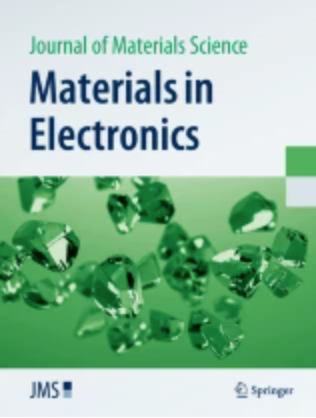合成时间对非热射流等离子体制备ZnO NPs/nSi异质结光电探测器性能的影响
摘要
在本研究中,利用非热氩射流等离子体(NTP)在不同的合成时间(8、12和16 min)下制备了氧化锌纳米颗粒(ZnO NPs)基光电探测器。采用40℃滴铸法制备纳米颗粒沉积在玻璃和硅衬底上。在施加电压为14 kV、气体流速为3 L/min的条件下,对非热大气射流等离子体(NTAPJ)进行了操作,计算了等离子体参数,以验证其制备纳米颗粒的稳定性和效率。利用x射线衍射(XRD)、能量色散x射线分析(EDX)、原子力显微镜(AFM)、场发射扫描电镜(FE-SEM)、紫外-可见光谱(UV-Vis)和光致发光(PL)光谱技术,系统研究了ZnO NPs合成时间对沉积在玻璃基底上的ZnO NPs薄膜和ZnO NPs/Si复合材料的结构、形貌、形态和光学性能的影响。随着合成时间的延长,FE-SEM图像显示ZnO纳米颗粒和纳米壁的形貌发生了显著变化,晶粒分布、密度增大、厚度增加,发育结晶规律,结构更优。ZnO纳米颗粒薄膜在400 nm以下表现出较强的吸收特性。光能带隙(\({\text{E}}_{{\text{g}}}\))分别为3.8、3.7和3.6 eV,表明晶体尺寸减小,厚度增加。拉曼光谱显示,在204-190厘米毒血症(E1 (LO)), 406厘米毒血症(E1 (TO))和565厘米毒血症(A1 (LO))处,16分钟时强度增加,表明结晶度有所提高。EDX显示Zn含量从6.5开始增加% to 17.8%. XRD revealed peaks at (100), (002), and (101), confirming the wurtzite structure with a decreasing crystalline size, which reflects a quantum confinement effect and improved crystallinity. The duration of synthesis by jet plasma was observed to affect the ZnONP's topographical roughness parameters. This study explores the impact of non-thermal plasma synthesis time on the physical properties and performance of nanostructured zinc oxide photodetectors in the UV–Vis region. This study highlights the impact of synthesis time on the ZnONPs/Si photodetector's figure of merit characteristics. It was found that the device performed best at a synthesis time of 16 min, with a responsivity of 24.8 A/W, EQE of 54%, and detectivity of 153.1 × 1011 Jones at -5 V bias voltage. In addition, it demonstrated stable and unchanged properties with rise and recovery times of 0.25 s and 0.27 s, respectively. These findings can have a significant role in promoting the ZnONPs/Si photodetector responsivity.Graphical AbstractIn this study, zinc oxide nanoparticles (ZnO NPs)-based photodetectors were fabricated using non-thermal argon jet plasma (NTP) at different synthesis times (8, 12, and 16 min). The nanoparticles were deposited on glass and silicon substrates by drop-casting at 40 °C. The non-thermal atmospheric jet plasma (NTAPJ) was operated at an applied voltage of 14 kV and a gas flow rate of 3 L/min, and the plasma parameters were calculated to confirm its stability and efficiency in producing nanoparticles. The effect of ZnO NPs synthesis time on the structural, topographical, morphological, and optical properties of ZnO NPs films deposited on glass substrates and of ZnO NPs/Si composites was systematically studied using X-ray diffraction (XRD), energy-dispersive X-ray analysis (EDX), atomic force microscopy (AFM), field emission scanning electron microscopy (FE-SEM), UV–Vis spectroscopy, and photoluminescence (PL) spectroscopy techniques. As the synthesis time increases, FE-SEM images reveal a notable change in the morphology of ZnO nanoparticles and nanowalls, including grain distribution, higher density, and increased thickness, indicating regular development and crystallization, which demonstrates a better structure. The optical properties of ZnO nanoparticle thin films show strong absorption below 400 nm. The optical energy band gap (\({\text{E}}_{{\text{g}}}\)) was calculated to be 3.8, 3.7, and 3.6 eV, indicating reduced crystalline size and increased thickness. Raman spectra showed peaks at 204–190 cm⁻1 (E1 (LO)), 406 cm⁻1 (E1 (TO)), and 565 cm⁻1 (A1 (LO)), with increased intensity at 16 min, indicating improved crystallinity. EDX revealed an increase in Zn content from 6.5% to 17.8%. XRD revealed peaks at (100), (002), and (101), confirming the wurtzite structure with a decreasing crystalline size, which reflects a quantum confinement effect and improved crystallinity. The duration of synthesis by jet plasma was observed to affect the ZnONP's topographical roughness parameters. This study explores the impact of non-thermal plasma synthesis time on the physical properties and performance of nanostructured zinc oxide photodetectors in the UV–Vis region. This study highlights the impact of synthesis time on the ZnONPs/Si photodetector's figure of merit characteristics. It was found that the device performed best at a synthesis time of 16 min, with a responsivity of 24.8 A/W, EQE of 54%, and detectivity of 153.1 × 1011 Jones at -5 V bias voltage. In addition, it demonstrated stable and unchanged properties with rise and recovery times of 0.25 s and 0.27 s, respectively. These findings can have a significant role in promoting the ZnONPs/Si photodetector responsivity.

 求助内容:
求助内容: 应助结果提醒方式:
应助结果提醒方式:


